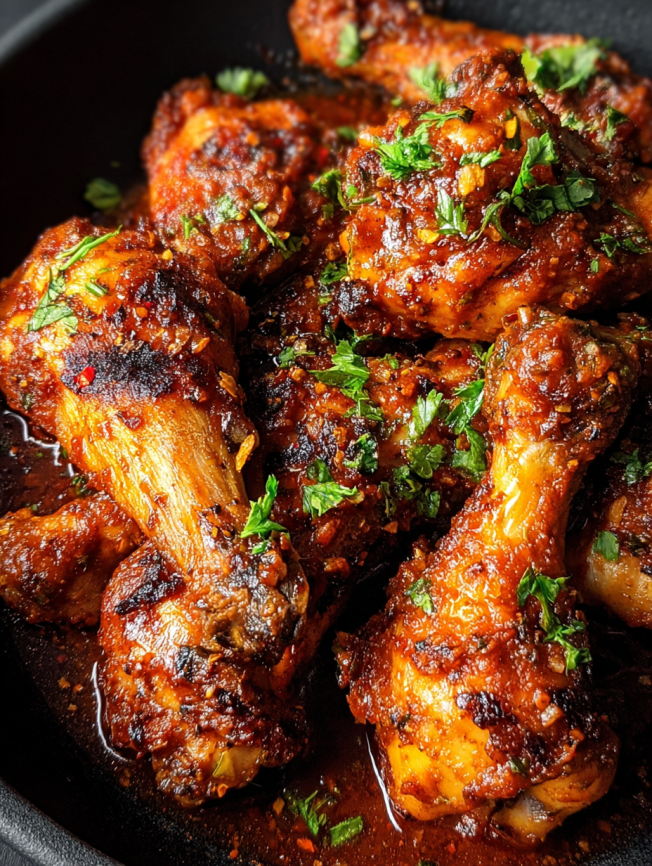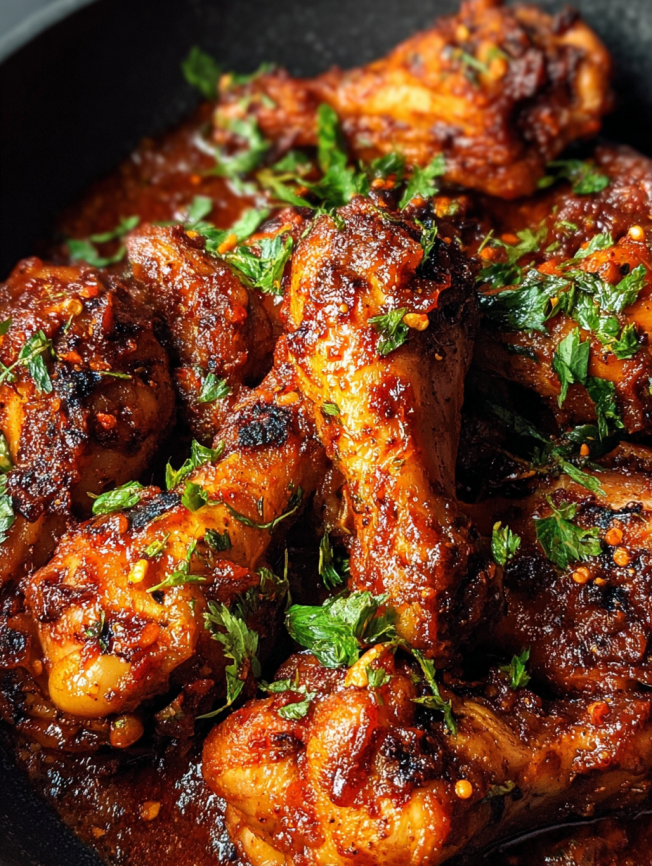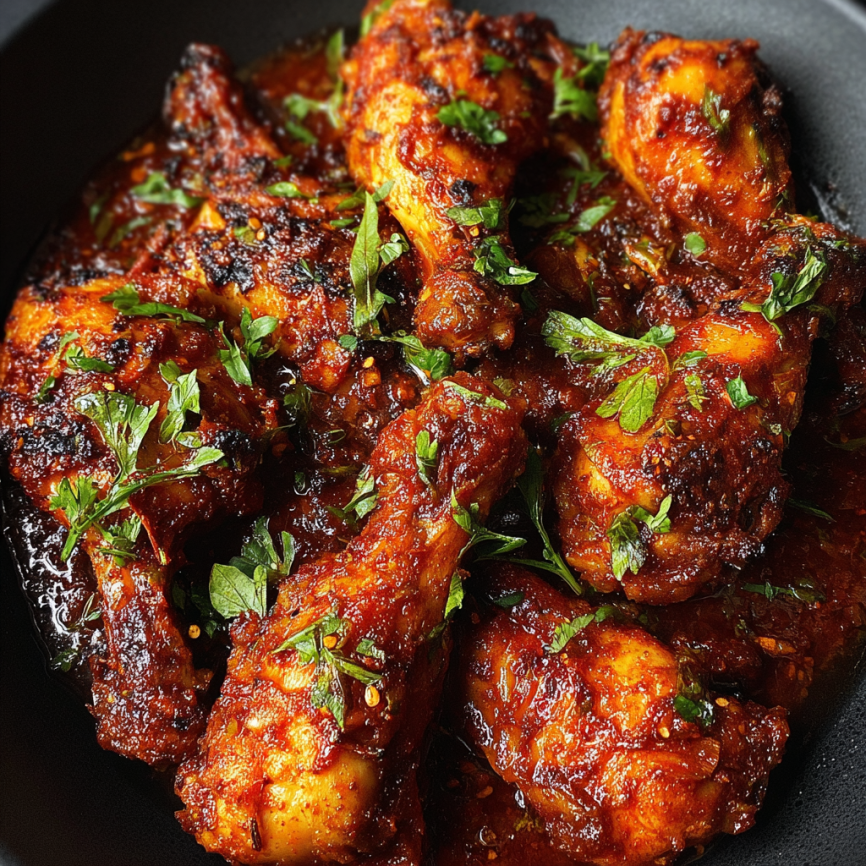The first time I tasted Moambe Chicken was at a small family gathering hosted by my Congolese friend Marie. As the rich, amber-colored sauce clung to tender chicken pieces, filling the room with an intoxicating aroma of peanuts, palm oil, and warm spices, I knew I was experiencing something truly special. This wasn’t just dinner – it was a cultural embrace, a story told through flavors that had been perfected over generations.
Years later, this iconic dish has become one of my most treasured recipes. Every time I prepare it, I’m transported back to that evening of warmth, laughter, and incredible food. Furthermore, I’ve discovered that this traditionally rich dish can be adapted beautifully for modern healthy eating without losing any of its soul-satisfying essence.
Why You’ll Be Obsessed with This Recipe
A Window into Authentic African Cuisine
Moambe Chicken, also known as Poulet Moambe, represents the very essence of Central African cooking. This isn’t fusion or interpretation – it’s the real deal, passed down through generations in Congolese kitchens. When you master this recipe, you’re connecting with a culinary tradition that spans centuries.
Complex Flavors Made Simple
Despite its sophisticated flavor profile, this dish is surprisingly approachable for home cooks. The combination of creamy peanut butter, aromatic palm oil, and carefully balanced spices creates layers of taste that seem complex but require no advanced techniques to achieve.
Perfect for Health-Conscious Food Lovers
This low-carb adaptation maintains all the traditional flavors while fitting seamlessly into modern dietary preferences. Rich in protein and healthy fats, it’s naturally keto-friendly and incredibly satisfying without the need for heavy starches.
Impressive Yet Accessible
Whether you’re hosting dinner guests or simply want to elevate a weeknight meal, Moambe Chicken delivers restaurant-quality results with pantry-friendly ingredients. Moreover, it’s the kind of dish that gets people talking and asking for the recipe.
Essential Ingredients for Authentic Flavor
The Protein Foundation
- 2 pounds chicken (drumsticks or thighs preferred for optimal flavor)
- 2 tablespoons olive oil for browning
Aromatic Base
- 1 large onion, chopped
- 4 garlic cloves, minced
- 1 teaspoon fresh ginger, minced
- 2 tablespoons tomato paste
Signature Spice Blend
- 1 tablespoon smoked paprika
- 1 teaspoon cayenne pepper (adjust to taste)
- 1 bay leaf
- Salt and freshly ground black pepper
The Heart of the Dish
- 1 cup natural peanut butter (unsweetened)
- 1 cup palm oil or red palm butter
- 1 cup quality chicken broth
Serving Companions
Consider pairing with cauliflower rice, steamed collard greens, plantains, or roasted vegetables for a complete meal experience.
Step-by-Step Cooking Instructions
Building the Flavor Foundation
Heat olive oil in a large, heavy-bottomed skillet over medium heat. Season chicken pieces generously with salt and pepper, then brown them on all sides until golden. This browning step is crucial for developing deep flavor throughout the dish. Once browned, remove chicken and set aside on a plate.
Creating the Aromatic Base
Using the same skillet with those delicious browned bits, add chopped onion and sauté for 2-3 minutes until it becomes translucent and fragrant. Next, add minced garlic and ginger, cooking for another minute while stirring constantly to prevent burning.
Developing the Spice Profile
Stir in tomato paste, smoked paprika, cayenne pepper, salt, and pepper, cooking for about 30 seconds until the spices become fragrant. This step blooms the spices and creates a rich base for your sauce.
Bringing It Together
Pour in chicken broth, scraping up any browned bits from the bottom of the pan. Return the chicken pieces to the skillet and add the bay leaf. Bring the mixture to a gentle simmer, then cover and cook on low heat for 25-30 minutes, stirring occasionally to prevent sticking.
The Signature Sauce Creation
While the chicken simmers, prepare the moambe sauce in a separate saucepan. Gently melt the peanut butter with palm oil over low heat, whisking constantly until the mixture becomes smooth and well combined. This process should take about 5 minutes.
Final Assembly and Cooking
Pour the peanut-palm mixture over the chicken, stirring gently to coat all pieces. Remove the lid and simmer uncovered for another 15 minutes, allowing the sauce to thicken and develop its characteristic rich consistency. The sauce should coat the chicken beautifully and have a glossy, amber appearance.

Creative Serving Suggestions
This versatile dish pairs wonderfully with various accompaniments depending on your dietary preferences and cultural curiosity. For a traditional experience, serve over steamed white rice or with boiled cassava. However, for a low-carb approach, cauliflower rice provides an excellent neutral base that soaks up the flavorful sauce.
Consider offering it family-style with an array of African-inspired sides like sautéed spinach with garlic, roasted sweet potatoes, or simple steamed vegetables. The rich sauce also pairs beautifully with warm flatbread for dipping.
Delicious Recipe Variations
Vegetarian Moambe
Replace chicken with hearty vegetables like eggplant, okra, and mushrooms. Use vegetable broth instead of chicken broth and add extra protein with tofu or tempeh. The cooking method remains the same, though vegetables may require less simmering time.
Seafood Moambe
Substitute firm fish like tilapia or catfish for the chicken. Reduce cooking time significantly, as fish cooks much faster than chicken. Add the fish during the last 10 minutes of cooking to prevent overcooking.
Spicy Moambe
Increase the cayenne pepper or add fresh scotch bonnet peppers for those who love heat. You can also incorporate a tablespoon of harissa paste for additional complexity and warmth.
Make-Ahead Strategies
Prep Work Advantages
Chop all vegetables and measure spices up to two days in advance. Store them in separate containers in the refrigerator until ready to cook. This preparation makes the actual cooking process much smoother.
Sauce Preparation
The peanut-palm sauce can be prepared separately and stored in the refrigerator for up to three days. Gently reheat before adding to the chicken for the final cooking stage.
Complete Dish Storage
Moambe Chicken actually improves in flavor after a day or two in the refrigerator. Store covered for up to four days, and reheat gently on the stovetop, adding a splash of broth if the sauce becomes too thick.
Expert Tips for Perfect Results
Understanding palm oil is crucial for authentic flavor. If you can’t find palm oil, you can substitute with a combination of coconut oil and a pinch of paprika for color, though the flavor will be slightly different. Never substitute the natural peanut butter with sweetened versions, as this will alter the dish’s balance completely.
Temperature control matters significantly throughout the cooking process. Keep heat at medium or lower to prevent the peanut butter from separating or burning. Patience during the simmering stages allows flavors to meld properly and creates the silky sauce texture that defines great Moambe Chicken.
Always taste and adjust seasoning at the end. The saltiness of your broth and peanut butter may vary, so final seasoning adjustments ensure the perfect balance of flavors.

Frequently Asked Questions
What exactly is palm oil, and where can I find it? Palm oil is a reddish oil extracted from palm fruit, available at African markets, international grocery stores, or online. Look for unrefined red palm oil for the most authentic flavor and color. If unavailable, coconut oil with paprika can substitute, though the taste will differ.
Can I use crunchy peanut butter instead of smooth? While traditional recipes use smooth peanut butter, crunchy can work if you prefer texture. However, the sauce won’t be as silky, and some people find the peanut pieces distracting from the overall experience.
Is this dish very spicy? The heat level is completely adjustable. Without cayenne pepper, the dish is quite mild. Start with less spice and gradually increase according to your tolerance. The richness of the peanut butter and palm oil helps balance any heat.
How do I know when the chicken is fully cooked? Chicken should reach an internal temperature of 165°F (74°C). Additionally, the meat should easily pull away from the bone, and juices should run clear when pierced with a knife.
Can I freeze leftover Moambe Chicken? Yes, it freezes well for up to three months. However, the sauce may separate slightly upon thawing. Reheat gently and whisk to recombine, adding a little broth if needed to restore the proper consistency.
What’s the difference between this and other African peanut stews? While many West and Central African countries have peanut-based stews, Moambe Chicken is specifically Congolese and distinguished by its use of palm oil, the specific spice combination, and cooking technique that creates its characteristic sauce consistency.
Prep Time: 15 minutes | Cooking Time: 45 minutes | Total Time: 1 hour
Calories: 430 kcal per serving | Servings: 6

